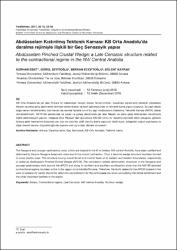Abdüsselam Kıstırılmış Tektonik Kaması: KB Orta Anadolu'da daralma rejimiyle ilişkili bir Geç Senozoyik yapısı
Özet
KB Orta Anadolu'da yer alan Ankara'nın batısındaki Neojen öncesi temel birimler, kabuktaki daralmanın etkisiyle yükselerek Neojen ve daha genç sedimanter birimleri deforme eder ve kesit görüntüsünde bir tektonik kama yapısı oluşturur. Eş yaşlı olarak doğu kenarı bindirme/ters, batı kenarı ise normal faylarla sınırlı bu yapı Abdüsselam Kıstırılmış Tektonik Kaması (AKTK) olarak isimlendirilmiştir. AKTK'nin çevresinde ve kuzey ve güney devamında yer alan Neojen ve daha genç birimlerdeki daralmayla ilişkili deformasyon yapıları, bölgede Orta Pliyosen'den günümüze KB-GD yönlü bir daralma rejiminin etkin olduğunu gösterir. Ankara şehir merkezinin batısında yer alan ve olasılıkla aktif olan bu kama yapısıyla ilişkili faylar, bölgedeki yoğun yapılaşma ve diğer önemli tesisler düşünüldüğünde deprem riski açısından dikkate alınmalıdır. The Neogene and younger sedimentary units, which are located in the W of Ankara, NW central Anatolia, have been uplifted and deformed by the pre-Neogene basement rocks due to the crustal contraction. Thus, a tectonic wedge structure has been formed in cross-section view. This structure having coeval thrust and normal faults at its eastern and western boundaries, respectively, is called as AbdÜsselam Pinched Crustal Wedge (APCW). The contraction related deformation structures in the Neogene and younger sedimentary units around the APCW and along its northern and southern continuation show that the NW-SE-directed contractional regime has been active in the region since Middle Pliocene. Therefore, the faults related to the APCW located in the west of Ankara city center should be taken into consideration for the earthquake risk when considering the dense settlement and the other important facilities in the region.
Kaynak
YerbilimleriCilt
38Sayı
1Bağlantı
http://www.trdizin.gov.tr/publication/paper/detail/TWpRM01qa3dNQT09https://hdl.handle.net/11421/22941


















